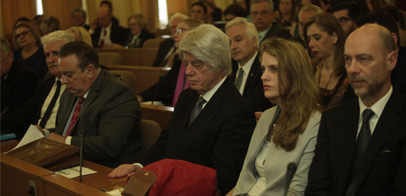
(By: George S. Kounoupis, J.D.)
Why discuss US Federal Court and Administrative Agency/EEOC Mediation? Because those programs have been very successful, resulting in a civil case settlement rate of 40% to 70%. How is this helpful for those who do business and work in Greece? It is helpful because comparative legal analysis is one of the best tools known to international law for improving a legal system toward "rule of law" -which has efficiency as one of its hall marks. Because "justice delayed is justice denied". Why discuss Greek and US legal civil procedure in an article on mediation? Because mediation can best be understood in that context.
In the city of Philadelphia, if you circle around City Hall, with its statue of Benjamin Franklin at the very top, and you travel down to 9th and Market Street you can find the Mediation Unit of the Equal Employment Opportunity Commission (EEOC) on the 13th floor. (The EEOC is part of the US Department of Labor.) There, displayed prominently on the wall, is a plaque with the quote, "I was never ruined but twice: Once when I lost a lawsuit and once when I won one." Voltaire.
In this article, I discuss the evolution of dispute resolution in the US, focusing on mediation (because arbitration is fundamentally different). A strong proponent for mediation was US Supreme Court Chief Justice Burger who in 1984 stated, "Our system is too costly, too painful, too destructive, too inefficient for a truly civilized people. To rely on the adversary process as the principal means of resolving conflicting claims is a mistake that must be corrected."
The impetus created by such observations as well as the increasing court backlogs resulted in Congressional findings in the 1990s that a "measure of economy and efficiency are a precondition for delivery of Justice" which must be balanced against "thoughtful deliberation on merits". Moreover, it was determined that court delays and backlogs burdened the economy and impeded international competition (similar to the factors stressed by the OECD in its recommendations on Greece and recently in its 2016 EU Justice Scoreboard). Those Congressional findings led to the Civil Justice Reform Act of 1990. This 1990 Act implemented three critical ideas:
- An Administrative Court Office constantly monitoring the Courts and collecting empirical data;
- Fundamental recognition of the proposition that a judge cannot "buy time" by rescheduling a trial to a future date; and
- Placing responsibility for local case docket management on judges and implementing "Magistrate Judges". The idea of judges as "managers". The federal courts were directed to consider implementing ADR programs under this Act.
The Civil Justice Reform Act of 1990, was followed by the Administrative Dispute Resolution Act of 1996 which implemented ADR procedures in administrative agencies. Finally, the ADR Act of 1998 made the implementation of ADR programs mandatory in the US Federal Courts. With the regard to the mandatory implementation of mediation in the US Federal Court System, the keys to its success may be summarized as:
- Support by lawyers and judges;
- Properly trained, neutral mediators;
- Program adequately administered by the courts; and
- Early neutral evaluation.
The effect of the above has resulted in significant reductions in US Federal Court backlogs and currently only 4% of federal civil cases go to trial. This is quite an achievement considering a very litigious nation of our 300 million population and over 800,000 lawyers.
The key to the success of mediation in the federal court system, as implemented by the above statutes, lies in its specific mandatory application by the federal courts. When a complaint is filed in federal court a judge is immediately assigned and there start to run short deadlines to serve (90 days/Rule 4); to answer or counterclaim or move to dismiss (30 days/Rule 12). Concurrently, within 3050 days of filing the complaint the judge schedules a "Rule 16" Conference before which the parties must confer, set up a proposed schedule for "discovery", discuss settlement and provide a "Joint Report" to the Court regarding their discussions. At this, Rule 16 Conference, the Judge sets up deadlines for discovery (the requirement that proofs be put on record or else the case is dismissed pretrial under Rule 56, Summary Judgement); and after 90-120 days of discovery, a trial or pretrial date is set within less than 6 months in most cases. At the Rule 16 Conference however, the judge also refers the case to a Magistrate Judge for a Settlement Conference (i.e. mediation). This Settlement Conference is held by the Magistrate Judge in the Courtroom with the parties and their lawyers required to attend. After extensive discussions and separate caucuses with the Magistrate Judge a great number of cases -almost 40%, settle.
| Similarly, in the administrative agency, EEOC, which as we have said is part of the US Department of Labor, mediation is applied with great efficiency early on. The EEOC receives tens of thousands of complaints annually because all employment discrimination or harassment cases in the private and many public sectors must first be filed for administrative review by the EEOC before they can be filed in any court. Upon receipt of a Charge of violation, the EEOC asks the parties if they want to mediate early on. If both parties agree, investigation is frozen and the Charge is sent to a separate "Mediation Unit" staffed by qualified neutral mediators. A mediation date is set and a mediator is assigned by the agency at no cost. The parties must sign confidentiality agreements as part of their agreement to mediate - so that nothing said in mediation can be used it court. The important thing is that if there is a settlement at mediation the defendant avoids the risk of an investigation proceeding. If there is a private settlement later, even if the parties settle, the EEOC/government does not have to accept any such settlement. The EEOC mediation rate is very high and my personal success rate, having mediated for over 20 years, is about 70%. |
However, as the above article indicates, the administration by the US court system and the implementation by the civil procedure system for mediation is critical. In Greece, the amendments to the Greek Code of Civil Procedure 4335/2016 are to be commended for speeding up the litigation process. As per EU Directives, mediation is built into the Greek Code of Civil Procedure (for example, now under Article 209 of the Greek Code of Civil Procedure, the parties can request court settlement intervention before filing a lawsuit; and there is now, a strong statement in Article 116 in the new Greek Code of Civil Procedure indicating the courts "support of mediation"). But it is not mandated, applied, implemented and more importantly accepted at this time as it is in the US.
In conclusion, therefore, the US administrative law and federal court civil procedure system is designed to incorporate mediation effectively utilizing federally appointed mediators and/or Federal Magistrate Judges. Since specific legislation in the 1990's made ADR a mandatory and integrated part of the federal administrative and court dispute resolution process, efficiency has been increased and backlogs have been significantly reduced.
George S. Kounoupis is the ABA Liaison to Greece and is the former Chair of the ABA's Lawyers Practicing Abroad Committee. He is both a US and Greek Lawyer and this holds dual qualifications. After several years as a corporate litigator at one of the largest US law firms he formed his own law firm specializing in international law and litigation. Recognized as one of the top US litigators by Martindale-Hubell (AV rating), SuperLawyers, The National Trial Lawyers, The Litigation Counsel of America, Million Dollar Advocacy and Whos Who Legal, he has tried hundreds of US cases and, has over 150 published court opinions.



















